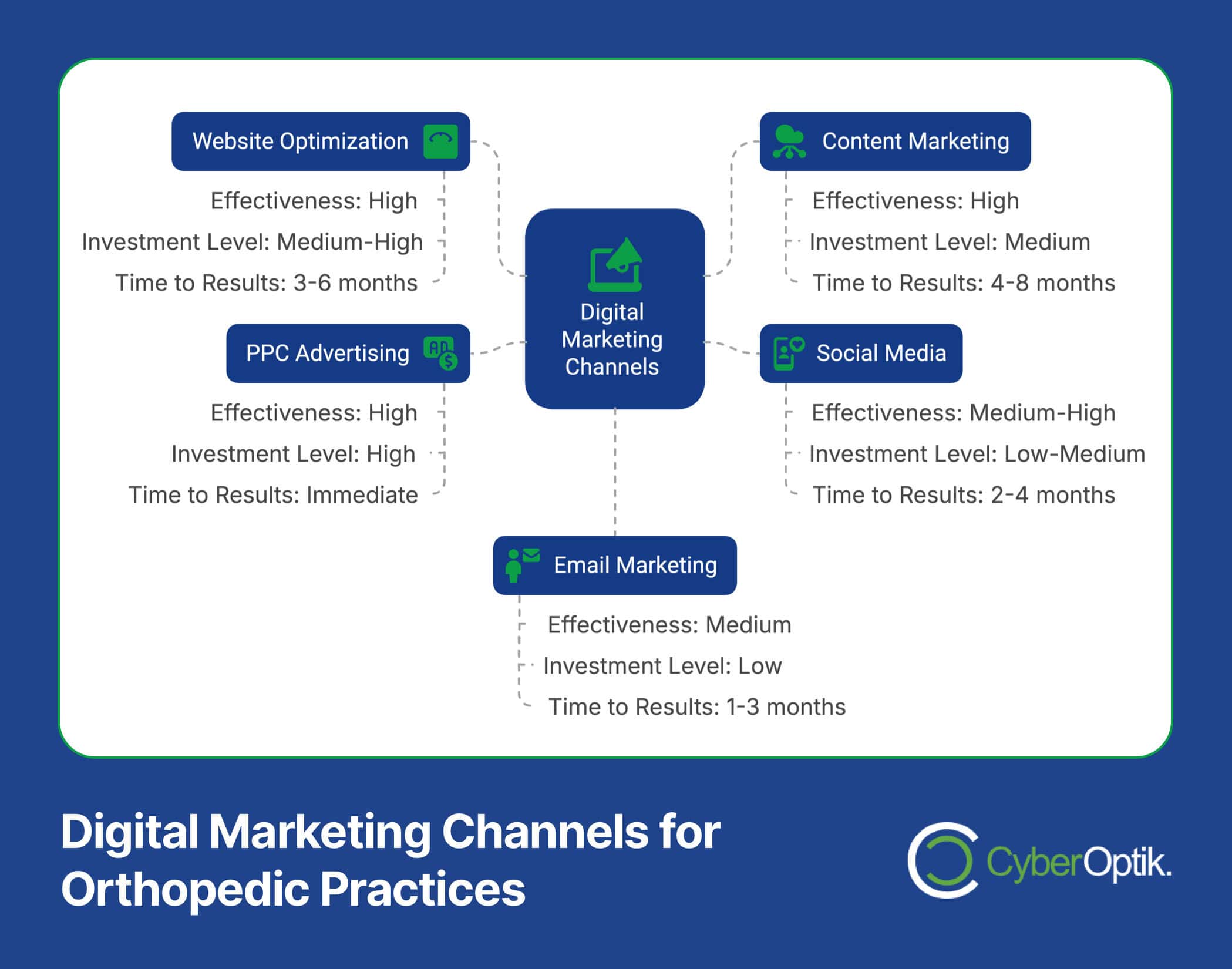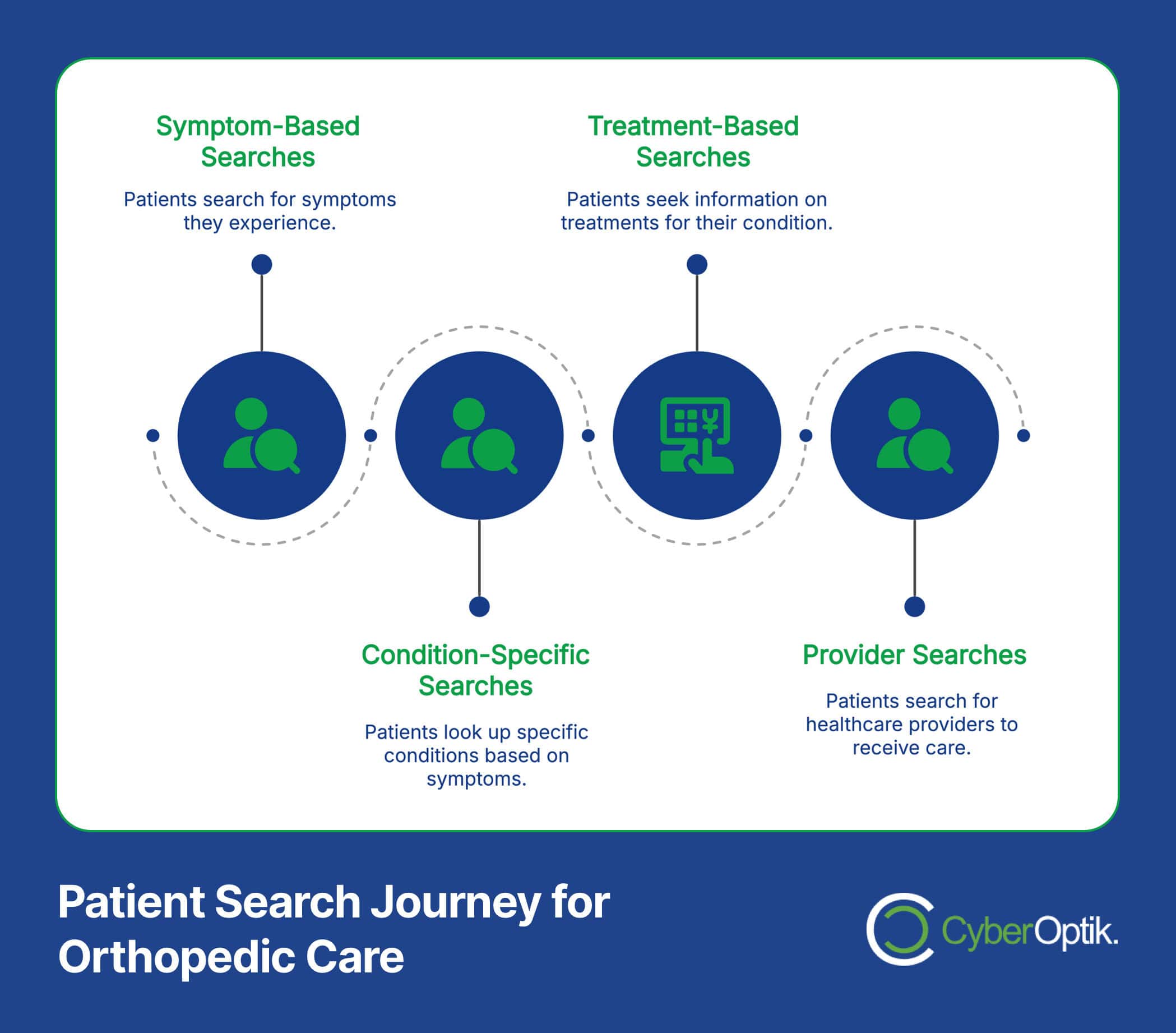Orthopedic surgeons face unique challenges in today’s digital marketplace. With approximately 7 million orthopedic surgeries performed annually in the US, the competition for patients is fierce. (Source: Digital Spotlight)
Digital marketing offers powerful tools for practice growth. Many surgeons focus solely on clinical excellence while neglecting their online presence. This creates a significant opportunity for those who invest in strategic marketing.
We understand the challenges orthopedic surgeons face. Balancing patient care with business growth requires strategic marketing approaches that deliver real results. Our expertise in healthcare digital marketing has shown what truly works for medical practices.
This guide explores proven strategies to boost your online visibility. You’ll discover website optimization techniques, content strategies, social media approaches, and reputation management tactics specifically designed for orthopedic practices.
Understanding the Digital Industry for Orthopedic Surgeons

The digital industry has transformed how patients find doctors. Research shows that 50.9% of orthopedic patients use the internet to choose hospitals and surgeons. (Source: JMIR Formative Research)
This shift in patient behavior creates both challenges and opportunities. Today’s patients conduct extensive research before making appointments. They evaluate your credentials, patient reviews, and website quality before picking up the phone.
Understanding how patients search for orthopedic care is essential. Many start with condition-specific terms rather than looking directly for surgeons. They often begin with symptom searches before narrowing down to treatment options.
Analysis of orthopedic surgeons’ digital footprints shows significant variability in online presence. Surgeons with comprehensive digital strategies typically demonstrate stronger market positioning than those with minimal online visibility. (Source: JAAOS Global Research & Reviews)
| Digital Marketing Channel | Effectiveness for Orthopedic Practices | Investment Level | Time to Results |
|---|---|---|---|
| Website Optimization | High | Medium-High | 3-6 months |
| Content Marketing | High | Medium | 4-8 months |
| Social Media | Medium-High | Low-Medium | 2-4 months |
| PPC Advertising | High | High | Immediate |
| Email Marketing | Medium | Low | 1-3 months |
This comparison highlights the varied approaches available to orthopedic practices. Each channel offers distinct advantages for reaching and engaging potential patients.
Common Patient Search Behaviors
Understanding patient search behavior improves your marketing strategy. Most potential patients use specific patterns when looking for orthopedic care. Their journey typically begins with symptoms rather than providers.

Many searches follow a progression from general to specific. Patients start with terms like “knee pain” and eventually search for “knee replacement surgeon near me.” This knowledge helps optimize your content for different stages of the patient journey.
- Symptom-based searches: “Joint pain,” “Back pain causes,” “Shoulder pain when lifting”
- Condition-specific searches: “ACL tear,” “Herniated disc,” “Rotator cuff injury”
- Treatment-based searches: “Knee replacement surgery,” “Minimally invasive spine surgery”
- Provider searches: “Best orthopedic surgeon near me,” “Sports medicine doctor [city]”
Your digital strategy should address each stage of this search journey. Creating content that matches these patterns will improve your visibility to potential patients.
Website Optimization for Orthopedic Practices
Your website serves as your digital front door. First impressions happen online for many patients. A professional, patient-focused website builds trust before the first appointment.
Effective orthopedic websites balance clinical expertise with user experience. They showcase your credentials while making it easy for patients to find information and contact your office. Technical performance also matters for both patients and search engines.
We’ve found that orthopedic practices with optimized websites see substantial improvements in new patient acquisition. Key elements like mobile responsiveness, fast loading times, and clear calls-to-action directly impact conversion rates.
Essential Website Elements for Orthopedic Surgeons
Certain elements are particularly important for orthopedic practice websites. Your site should prominently feature credentials, specialties, and educational content about common procedures. Making appointment scheduling simple is also crucial.
Patient-centered design focuses on answering key questions quickly. Most visitors want to know about your expertise, accepted insurance plans, and available treatments. Highlighting these elements improves both user experience and conversion rates.
| Website Element | Importance | Best Practices | Common Mistakes |
|---|---|---|---|
| Mobile Responsiveness | Critical | Ensure all functions work on mobile devices; test on multiple screen sizes | Difficult navigation, tiny text, forms that don't work on mobile |
| Page Speed | High | Optimize images, use caching, minimize plugins | Large uncompressed images, excessive scripts, poor hosting |
| Procedure Information | High | Clear descriptions, recovery information, video explainers | Overly technical language, insufficient detail, no visuals |
| Appointment Booking | Critical | Prominent buttons, simple forms, online scheduling options | Hidden contact information, complex forms, no clear CTA |
| Physician Credentials | High | Certifications, education, specialties, professional photos | Outdated information, poor photos, buried credentials |
These website elements directly impact your practice’s online performance. Addressing these areas creates a foundation for effective digital marketing.
Custom WordPress website design offers particular advantages for orthopedic practices. The platform’s flexibility allows for specialized features like appointment scheduling, patient education resources, and HIPAA-compliant forms.
Technical SEO forms another crucial component of website optimization. Proper site structure, XML sitemaps, and schema markup help search engines understand your content. These technical elements improve visibility in search results.
Local SEO for Orthopedic Surgeons
Local search optimization directly impacts patient acquisition. Most orthopedic patients search for providers within their geographic area. Optimizing for local search puts your practice in front of these potential patients.
Google Business Profile management forms the cornerstone of local SEO. A complete profile with accurate information, regular posts, and patient reviews significantly improves local visibility. Consistency across all online directories also matters.
Local content development strengthens geographic relevance. Creating neighborhood-specific pages, highlighting local hospital affiliations, and mentioning nearby landmarks signals your service area to search engines.
Content Marketing Strategies for Orthopedic Surgeons
Strategic content marketing builds authority and attracts patients. Quality educational content establishes you as an expert while addressing common patient questions. This approach works particularly well for orthopedic specialists.
Effective content marketing starts with understanding patient concerns. Topics like recovery timelines, pain management, and non-surgical options generate significant interest. Addressing these areas creates value for potential patients.
We’ve found that orthopedic practices with consistent content strategies see improved search visibility. Regular blogging about relevant conditions and treatments helps your practice appear in more patient searches.
Content Types That Engage Orthopedic Patients
Different content formats serve various purposes in your marketing strategy. Educational blog posts build search visibility while video content engages visual learners. Case studies demonstrate your expertise with real patient outcomes.
Content should align with different stages of the patient journey. Early-stage content addresses symptoms and conditions, while later-stage content focuses on treatments and recovery. This approach captures patients throughout their decision process.
- Condition-specific guides: Comprehensive information about common orthopedic conditions
- Procedure explanations: Detailed but accessible descriptions of surgical techniques
- Recovery resources: Post-operative care instructions and rehabilitation guidance
- Patient testimonials: Real stories highlighting successful treatment outcomes
- Educational videos: Visual explanations of conditions and procedures
This content mix addresses different learning styles and information needs. Building a library of these resources establishes your practice as a trusted information source.
Content distribution extends your reach beyond your website. Sharing valuable content through email newsletters, social media, and patient portals increases engagement. This multi-channel approach maximizes the impact of your content investment.
Social Media Marketing for Orthopedic Practices
Social media provides powerful platforms for connecting with patients. Research shows a 620% increase in orthopedic training programs using Instagram post-COVID, indicating the growing importance of these channels. (Source: PMC)
Different platforms serve different purposes for orthopedic surgeons. LinkedIn works well for professional networking, while Instagram excels for visual education. Facebook combines patient engagement with community building potential.
Individual orthopedic surgeons’ social media usage varies widely, with Twitter/X usage ranging from 1.7% to 76% and Instagram usage from 0% to 61% among different subspecialties. (Source: PMC)
Platform Selection and Strategy
Choosing the right social platforms impacts your results. Most orthopedic practices benefit from starting with 2-3 platforms rather than trying to maintain presence everywhere. Focus on platforms where your target patients spend time.
Content strategy should vary by platform. Instagram content typically focuses on visual education and treatment results. LinkedIn content highlights professional achievements and educational content. Facebook combines community updates with patient resources.
| Social Platform | Best Uses for Orthopedic Surgeons | Recommended Content Types | Posting Frequency |
|---|---|---|---|
| Patient education, community building, reviews | Educational articles, patient stories, practice updates | 3-4 times weekly | |
| Visual education, treatment results, practice culture | Procedure explanations, before/after (anonymized), team highlights | 2-3 times weekly | |
| Professional networking, thought leadership, recruitment | Research highlights, conference participation, industry insights | 1-2 times weekly | |
| YouTube | Detailed education, procedure walkthroughs | Procedure explanations, patient education, Q&A sessions | 2-4 times monthly |
| Twitter/X | Industry news, research highlights, professional networking | Study comments, conference highlights, quick tips | 3-5 times weekly |
This platform comparison helps identify where to focus your social media efforts. Each channel requires a tailored approach for maximum effectiveness.
How can you improve your website’s user experience to complement your social media strategy? Ensuring consistent branding and seamless transitions between platforms creates a cohesive patient experience.
Social media advertising enhances organic efforts. Targeted ads can reach potential patients based on demographics, interests, and even specific health concerns. This paid approach complements organic content for faster results.
Online Reputation Management for Surgeons
Your online reputation significantly impacts patient acquisition. Potential patients routinely check reviews before scheduling appointments. Positive reviews build trust while negative ones can deter prospective patients.
Online rankings and traditional metrics have limitations for orthopedic surgeons. Less than 20% of the US population (Medicare enrollees) are represented in orthopedic rankings, creating an incomplete picture of quality. (Source: Healio)
Proactive reputation management includes monitoring and responding to reviews. Thoughtful responses to both positive and negative feedback demonstrate patient commitment. This engagement often improves overall sentiment.
Building a Positive Online Presence
Strategic reputation building extends beyond review management. Patient testimonials, case studies, and media mentions all contribute to your digital reputation. These elements create a more complete picture of your practice quality.
Review generation should be systematic rather than random. Implementing a consistent process for requesting reviews leads to more authentic feedback. Most satisfied patients will leave reviews when properly asked.
- Consistent review monitoring across Google, Healthgrades, Vitals, and other platforms
- Thoughtful response strategy for both positive and negative feedback
- Proactive review generation through systematic patient follow-up
- Showcase of credentials and achievements on your website and profiles
- Strategic content publishing that demonstrates expertise and patient focus
These reputation management elements work together to build trust with potential patients. A comprehensive approach yields better results than focusing solely on reviews.
Addressing negative feedback requires particular care. Professional, non-defensive responses demonstrate your commitment to patient satisfaction. This approach often converts critics into advocates over time.
Paid Advertising Strategies for Orthopedic Practices
Paid advertising offers immediate visibility for orthopedic practices. While organic strategies build long-term presence, paid campaigns deliver faster results. This approach works well for new practices or those promoting specific procedures.
Strategic campaign development starts with clear goals. Different objectives – from brand awareness to appointment booking – require different approaches. Aligning campaigns with specific business goals improves return on investment.
The digital world offers numerous advertising channels for orthopedic surgeons. (Source: PubMed) Each platform provides unique targeting capabilities and formats for reaching potential patients.
Effective Advertising Channels
Google Ads remains the cornerstone of most medical advertising strategies. These search-based ads reach patients actively looking for orthopedic services. Targeting specific conditions and treatments improves campaign performance.
Social media advertising complements search campaigns. These platforms offer sophisticated targeting based on demographics, interests, and behaviors. This precision helps reach potential patients before they begin actively searching.
- Google Search Ads: Target patients actively searching for orthopedic services
- Google Local Service Ads: Featured placement for local searches with “Google Guaranteed” badge
- Facebook/Instagram Ads: Demographic and interest-based targeting for awareness
- Display Remarketing: Re-engage website visitors who didn’t convert
- YouTube Video Ads: Educational content for conditions and procedures
This channel mix creates multiple touchpoints throughout the patient journey. Coordinating messaging across platforms strengthens your overall marketing impact.
Landing page optimization greatly impacts advertising success. Custom pages designed specifically for ad campaigns convert better than general website pages. These targeted pages should focus on a single action – typically appointment scheduling.
Measuring Success: Analytics for Orthopedic Marketing
Effective measurement drives continuous improvement. Tracking key metrics helps identify what’s working and what needs adjustment. This data-driven approach maximizes your marketing return on investment.
Different metrics matter at different sales funnel stages. Top-funnel metrics like impressions and reach measure awareness. Middle-funnel metrics track engagement. Bottom-funnel metrics count conversions like appointment requests.
We’ve found that orthopedic practices often focus too narrowly on appointment requests alone. Tracking the entire patient journey provides more actionable insights for optimizing your marketing strategy.
| Marketing Metric | What It Measures | Target Benchmarks | Improvement Strategies |
|---|---|---|---|
| Website Conversion Rate | Percentage of visitors who complete desired actions | 3-5% for healthcare sites | Improve calls-to-action, simplify forms, add testimonials |
| Cost Per Lead | Average cost to acquire a potential patient inquiry | $75-150 for orthopedic practices | Refine targeting, improve ad copy, optimize landing pages |
| Patient Acquisition Cost | Total marketing cost divided by new patients | $250-500 depending on specialty | Improve conversion from lead to patient, enhance follow-up |
| Return on Ad Spend | Revenue generated per dollar spent on advertising | 4:1 or higher for established practices | Focus on high-value procedures, improve targeting |
| Organic Search Visibility | Rankings for target keywords, organic traffic | First page rankings for specialty + location terms | Content development, technical SEO improvements |
Tracking these metrics helps optimize your marketing performance. Regular review of this data allows for continuous strategy refinement.
Over 50% of orthopedic patients use the internet to choose doctors, making digital performance tracking essential. The metrics above help ensure you’re capturing this online audience effectively.
Attribution modeling identifies which marketing channels drive results. Most patients interact with multiple touchpoints before scheduling. Understanding these patterns helps allocate resources more effectively.
Reporting and Continuous Improvement
Regular reporting provides visibility into marketing performance. Monthly reports should track key metrics against goals and historical performance. This consistent review process identifies trends and opportunities.
Data-driven optimization leads to continuous improvement. Testing different approaches – from ad copy to landing page design – reveals what resonates with your target patients. Small improvements compound over time for significant results.
Marketing technology simplifies data collection and analysis. CRM systems track patient journeys while analytics platforms measure marketing performance. This technology stack provides the insights needed for strategic decision-making.
Building an Effective Orthopedic Marketing Strategy
Effective digital marketing transforms orthopedic practice growth. The strategies outlined here provide a comprehensive framework for improving your online visibility and patient acquisition. Implementation should be strategic rather than scattered.
Prioritization matters for resource efficiency. Start with foundational elements like website optimization and Google Business Profile management. Build on this base with content development and targeted advertising.
We understand the unique challenges orthopedic surgeons face in marketing. Our experience with medical practices has shown that consistent, strategic implementation delivers the best results. Digital marketing success requires both expertise and persistence.
- Step 1: Audit your current online presence and identify gaps
- Step 2: Develop a strategic marketing plan with clear objectives
- Step 3: Implement foundational elements (website, local SEO)
- Step 4: Build content marketing and social media presence
- Step 5: Add targeted advertising for specific growth goals
Following this structured approach leads to sustainable practice growth. The digital landscape continues to evolve, but these core strategies remain effective for orthopedic surgeons.
Ready to transform your orthopedic practice’s online presence? Contact our team of Search Engine Optimization (SEO) specialists to learn how we can help implement these strategies for your specific situation.




